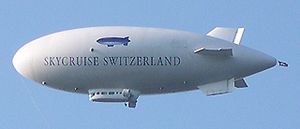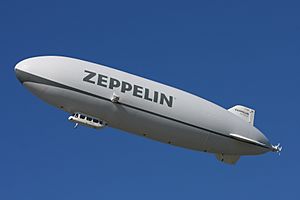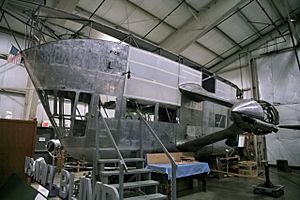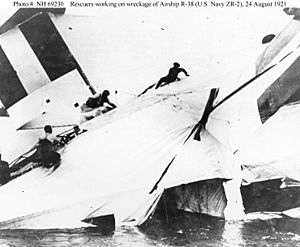Airship facts for kids
Airships are a special type of aircraft. They stay in the sky by floating, much like a balloon. This is different from airplanes, which stay up by moving forward quickly.
What makes an airship special? Unlike a simple balloon, an airship has an engine for power. It also has controls to steer it in different directions. This means airships can be guided where they need to go.
You might hear airships called "dirigibles." This word comes from French and means "steerable." Sometimes, people also use the word zeppelin. This term originally referred to airships made by the Zeppelin Company. Today, "zeppelin," "dirigible," and "airship" are often used to mean the same thing.
In the past, most airships used hydrogen gas to float. Hydrogen is lighter than helium and cheaper. However, hydrogen can easily catch fire when mixed with air. Because of this danger, American airships started using helium in the 1920s. Today, airships that carry passengers are not allowed to use hydrogen. Some small test airships still use hydrogen or even hot air, like a hot air balloon. These are sometimes called hotships.
Why Did Airships Decline?
Early airships were very successful and had a good safety record. For example, the Graf Zeppelin flew over 1 million miles without any passenger injuries. It even flew around the world!
However, as more airships were built, some serious accidents happened. These events showed the limits of airship technology at the time. Sadly, many famous airships eventually crashed.
The U.S. Navy lost all three of its large rigid airships in accidents. The USS Shenandoah broke apart in a thunderstorm in 1925. The USS Akron crashed into the sea during a strong downdraft in 1933. Both of these accidents caused many lives to be lost. The USS Macon broke apart in 1935 due to a structural problem.
Britain also had a major airship crash in 1930. The R 101 was a very advanced ship, but it was rushed into service. It crashed in France, and 48 people died. This accident led to the grounding of another British airship, the R 100, which was then sold for scrap.
The most famous airship accident was the burning of the Hindenburg on May 6, 1937. This event was widely reported and made people lose trust in airships. After this, faster and cheaper airplanes became the preferred way to travel.
Airplanes also had an advantage because they were less affected by wind. Airships found it hard to steer and dock in strong winds. Also, an airship's travel time could change a lot depending on whether it was flying with or against the wind. This made it difficult to keep to a schedule.
Modern Uses of Airships
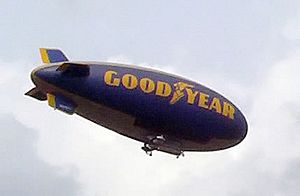
Even though airships stopped carrying passengers, they continued to be used for other jobs. The US Navy, for example, used them for many years.
In recent times, the Zeppelin company has started building airships again. Their new model, the Zeppelin NT, first flew in 1997. Several of these modern airships are now flying. For instance, an airship flew over Athens during the 2004 Summer Olympics to help with security.
Blimps are still very common today. You often see them used for advertising, flying over sports stadiums. They are also used as camera platforms to get amazing aerial views of major sporting events.
Images for kids
-
The LZ 129 Hindenburg was the largest airship ever built and was destroyed in 1937
-
Crossing of the English Channel by Blanchard in 1785
-
A model of the 1852 Giffard airship at the London Science Museum
-
Santos-Dumont No.6 rounding the Eiffel Tower in 1901
-
German airship Schütte Lanz SL2 bombing Warsaw in 1914
-
USS Shenandoah (ZR-1) during construction, 1923
-
The Hindenburg catches fire, 6 May 1937
-
A view of six helium-filled blimps being stored in one of the two massive hangars located at NAS Santa Ana, during World War II
-
Thermal airship (manufacturer GEFA-FLUG/Germany)
See also
 In Spanish: Dirigible para niños
In Spanish: Dirigible para niños


